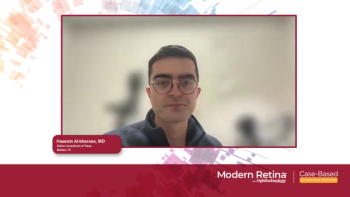
APAO 2023: Testing a treatment theory for children with keratoconus
The Keralink trial results answered an important question regarding the time at which corneal cross-linking should be performed.
The Keralink Trial, which began in 2016, was the first randomized clinical trial that tested the hypothesis that corneal cross-linking (CXL) might decrease keratoconus progression in children compared with the use of spectacles or contact lenses, the standard treatments for the disorder.
The results reported in late 2022 confirmed the efficacy and safety of epithelium-off rapid protocol CXL in patients aged 10 to 16 years with progressive keratoconus.1 The treatment benefit was sustained in most treated eyes out to 18 months, according to Frank Larkin MD, consultant ophthalmologist, Moorfields Eye Hospital, and Professor of Corneal Diseases (Hon.), University College London, UK.
He explained the multiple justifications for the trial, the first of which was the assumption that progression does not halt without CXL and it may have been on this basis that uncontrolled studies before Keralink had shown effectiveness.
In addition, with much increased availability of tomography to detect early keratoconus plus the availability of CXL, and there has been a large recent increase in diagnoses and referrals from optometrists of children with early keratoconus. When confirming approval of CXL for keratoconus, the National Institute for Clinical Excellence guidance in the UK highlighted the absence of quality evidence in children. Finally, there remains an uneven international regulatory position on CXL, availability, and cost coverage, he pointed out.
Keralink trial
The patients were randomized to (i) epithelium-off CXL in one or both eyes, or (ii) standard care. There was no placebo arm, and the investigators were masked to the randomised allocation.
The primary outcome was the steep keratometric (K2) meridian value in the study eye. Secondary outcomes were disease progression (defined as a greater than 1.5-diopter increase in K2 from randomization to 18 months or the change from spectacle to rigid contact lens correction), time to progression, uncorrected/best-corrected visual acuity (BCVA), refraction, apical corneal thickness, and quality of life.
Keralink results
Dr. Larkin reported that patients undergoing CXL in the study eye had an average K2 of 3 diopters lower than those receiving standard care at 18 months following randomization, a difference that reached significance (p=0.002, 95% confidence interval, -4.93, -1.08). The 95% confidence interval contains the clinically important difference of 1.5 diopters, which corresponds to keratoconus progression, he explained. The per-protocol analysis excluding cross-over patients did not change the observed intention-to-treat results.
The logMAR acuity uncorrected and BCVA at 18 months, respectively, were -0.31 (-0.50, -0.11; p=0.002) and -0.30 (-0.48, -0.11; p=0.002) and reached significance compared with the standard of care. No significant differences were seen in the study arms between apical corneal thickness and refraction and quality of life at 18 months.
The Keralink results answered an important question regarding the timing of CXL, i.e. CXL should not be performed at diagnosis in children because keratoconus can stabilize spontaneously in some eyes/patients, and CXL is not safe in all patients.
A currently unanswered question is if the threshold for intervening with CXL is different in children, given the greater risk of progression. There is no evidence thus far, according to Dr. Larkin. The recommendation is for the same threshold as in adult disease but follow-up examinations should be conducted at shorter intervals.
In addition, at this time there is no evidence to support the maximum keratometry (Kmax) value to monitor disease progression. K2 may be a better option.
Funding support from the UK’s NIHR Effectiveness & Mechanisms Evaluation programme (14/23/18) was acknowledged.
Reference
Larkin DFP, Choudhury K, Burr JM, et al. on behalf of the KERALINK Trial Study Group. Effect of corneal cross-linking versus standard care on keratoconus progression in young patients. The KERALINK randomized controlled trial. Ophthalmology. 2021;128:1516-26.
Newsletter
Keep your retina practice on the forefront—subscribe for expert analysis and emerging trends in retinal disease management.









































